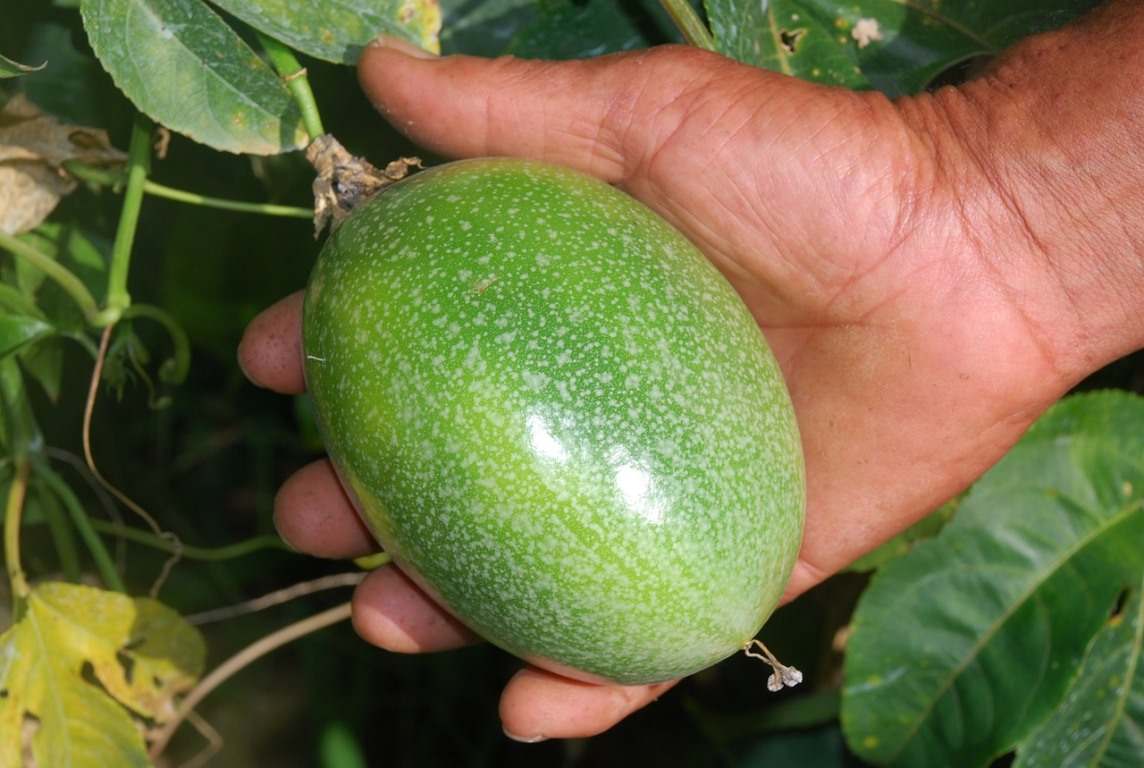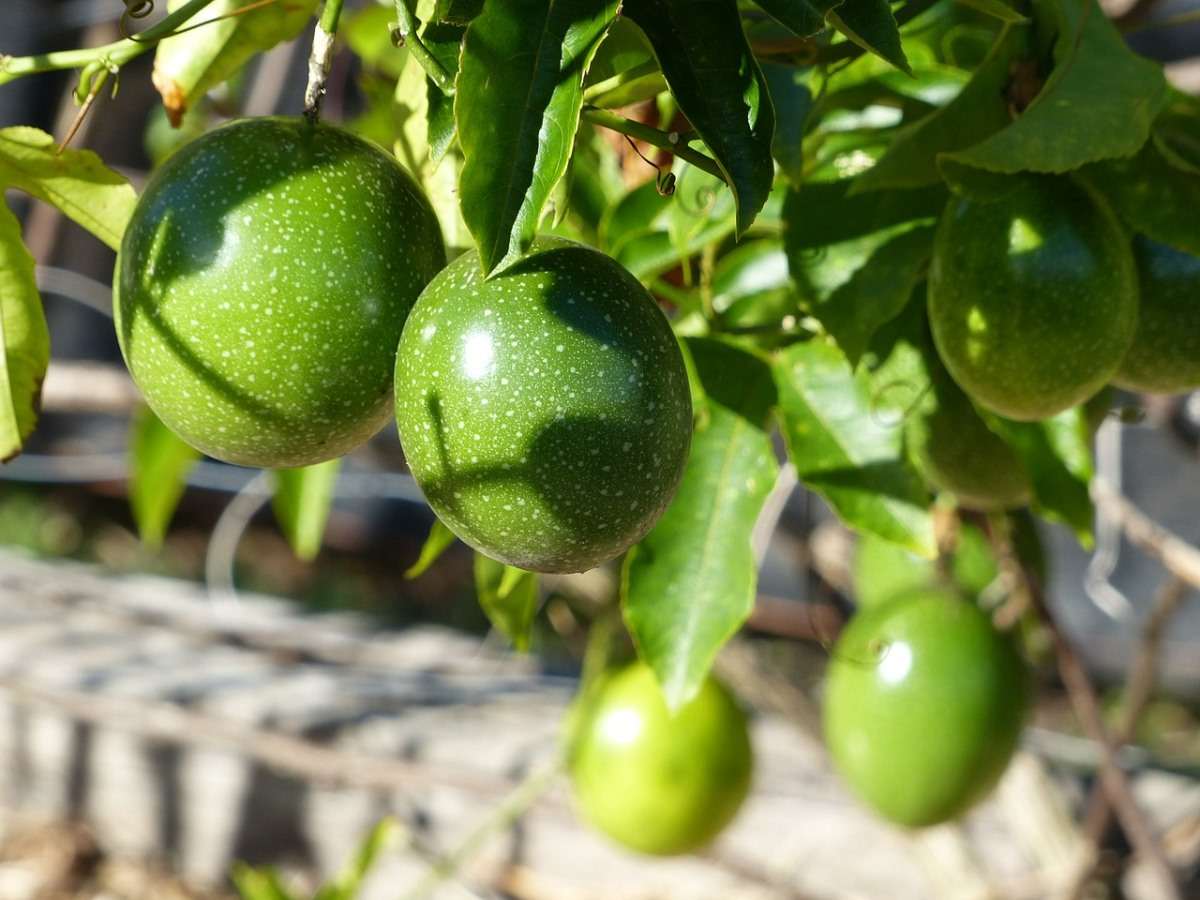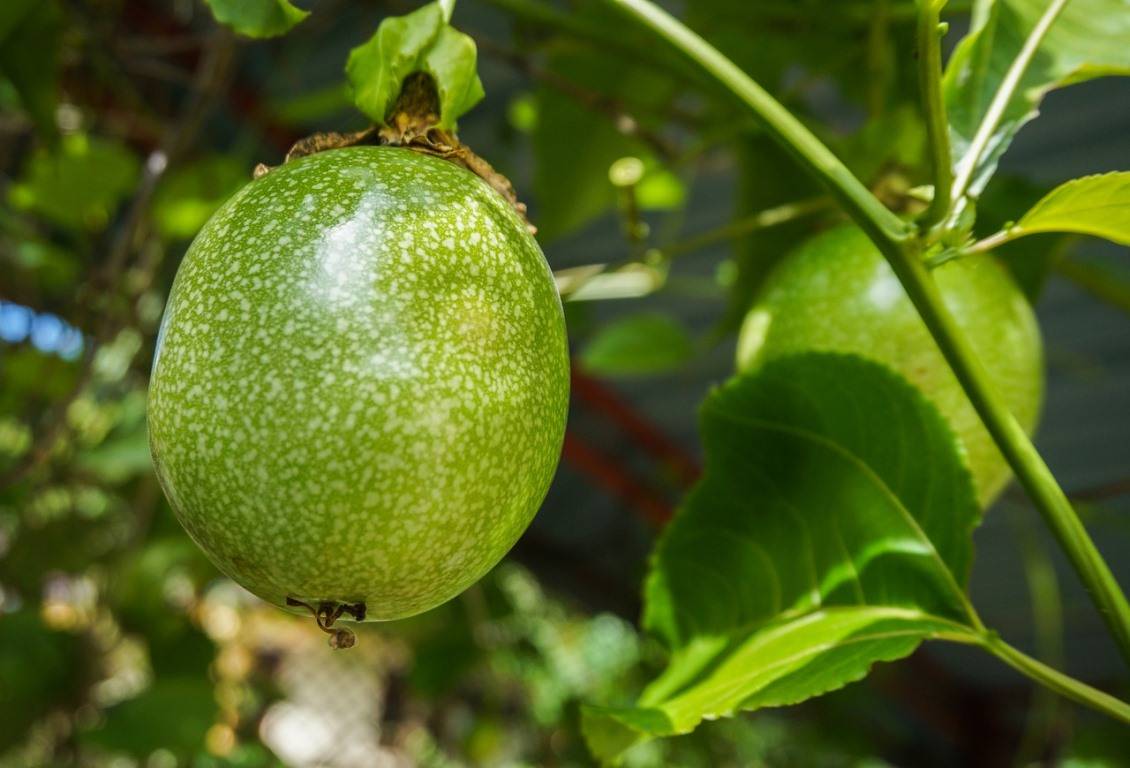Introduction to Passion Fruit Growing Tips, Techniques, Ideas, and Secrets – Passiflora edulis, commonly referred to as edible fruit, is a vine species of passion flower native to southern Brazil through Paraguay and even northern Argentina. It’s planted commercially in tropical and even subtropical areas for its sweet and seedy fruit.
A Guide for Passion Fruit Growing Tips, Techniques, Ideas, and Secrets

If you reside in a very warm climate and don’t experience harsh winters, then you can grow tropical edible fruit reception. The plant is often a touch finicky and wishes the room to open up, but with enough attention and care, it’ll provide you with a gentle yield of very delicious fruit.
Passion fruit is a vigorous and climbing vine that adheres by curly tendrils to almost any support. It can grow very quickly under very good conditions – up to 6 meters in one year. The evergreen leaves of the vine provide a shelter for the fragrant exotic-looking white and even purple flowers that appear on the new growth.
Basic Tips for Growing Passion Fruit
- Plant your passion fruit in moist and well-draining soil. Passion fruit survives in moist, fertile, and well-draining soil between a pH of 6.5 and 7.5, Fertilize your soil with mulch or organic matter compost if your soil appears too sandy or dry.
- Water your passion fruit generously without drowning it. Edible fruit plants need water but you would like to form sure that your soil drains well to stop plant disease. Water your plant regularly and even generously, while being careful that your soil is draining well.
- Give your plant many suns. Passion fruit plants usually thrive fully in sun and environments with 60 to 80% humidity.
- Prune the wilting vines. Passion fruit vines will bear more fruit if the vines are regularly pruned well. Prune the vines that have wilting leaves.
- Protect your plant from pests and disease. Use a mesh covering or liquid fence to guard your plant against aphids, snails, nematodes, and even gulf fritillary butterflies, all of which are common North American pests. You need to treat your plants with fungicide in early spring to stop fungal diseases like wilt or crown rot.
- Winterize your plant. If you reside in a tropical climate, your plant can fruit and flower year-round but it cannot survive in temperatures below 0°C. If the temperature drops below 0°C in winter, then add a layer of compost 2 inches thick over your plant’s root age to guard it against the cold.
- Propagate your plant with cuttings. You need to use a cutting of the latest growth from your passion fruit plant or even fresh seeds from one among your passion fruits to propagate a replacement plant. If employing a cutting, then trim the lower leaves, plant in a very small pot, and place in a warm place for up to 90 days, keeping the soil moist.
- Fertilize depleted soil. If your soil is looking dry or unhealthy, then add some 10-5-20 fertilizer to encourage growth. Confine mind that nitrogen-rich fertilizers will produce large passion fruit flowers but stunt fruit production. Choose a fertilizer with much potassium, adding it to your plant within the spring and summer.
Soil Preparation Tips for Growing Passion Fruit
The soil you plant your vines in should be well-draining, but rich and evenly moist. The addition of compost to the planting hole will help to provide nutrients, and even mulching around the plant’s base will assist in retaining moisture without having the plant become waterlogged. Typically, some sort of support is required for the vines to grow on—a trellis, a structure, or maybe on another plant.
- How does one prepare the soil for growing passion fruit?
The best time to plant a passion fruit vine is within the spring season. Before planting, you need to prepare your soil by incorporating compost and manure into a neighbourhood around one to 2 meters wide. Dig a hole twice as wide and even as deep because of the root ball, gently tease the roots, plant the vine and water well.
- What quite a soil does passion fruit usually like?
Sandy loam
Passion fruit grows best in well-drained, compost-rich, and sandy loam with a soil pH of 6.5 to 7.5. You need to avoid planting edible fruit where the soil is consistently wet. Also, avoid planting passion fruit plants in spots where it is often damaged by wind.
Tips for Growing Passion Fruit from a Seed
You can use the seeds from store-bought passion fruit to germinate and plant your own passion fruit vine. Here is the simple way to sow passion fruit from seed:
Choose a ripe passion fruit with a rather crinkled rind from the grocery, halve it, and extract its seeds. Wash any fruit pulp from your seed and dry them with a towel.
Prepare your seeds. To enhance the probabilities that your seeds will sprout, rub them between sheets of sandpaper and soak overnight for 12 hours. If you’re not planting your seeds immediately, then you need to store them in a sealed envelope or airtight container.
Germinate your seeds. To start the germination process, bury your seed in a suitable container crammed with a little amount of soil or seed-raising mix about an inch deep. Sow your seed slightly below the surface and water it to stay the soil moist. You’ll also need to use seaweed solution to urge help your seeds sprout more quickly
Water your seeds. Water your seed regularly to stay the soil moist, but don’t saturate it. Keep your container in a very warm place to facilitate moisture.
Wait until the seed sprouts out. Regularly water your seed until it sprouts. Some seeds germinate within two to three weeks, and a few as long as four. Other seeds will take up to four months to sprout, so twiddling my thumbs.
Re-pot your seedling. When your seedling is roughly 4 inches high, re-pot your plant in a larger pot, around 6 to 8 inches in diameter. Gently dig the seedling free, taking care to guard the basis system, and place in a good and fresh potting mix within the larger pot, water immediately. Provide your plant with climbing support so its vines can begin to grow. After roughly six weeks, your passion fruit plant should have an honest central vine—about eight inches in height—and are going to be able to plant within the garden against a trellis.
Prepare your soil. Choose an area in your garden that gets many suns to plant your sprouted seedling. Enrich your soil by combining it with fertilizer or mulch, and test the pH to form sure that it’s between 6.5 and 7.5. Loosen the soil to form sure that it’s draining properly.
Plant your vine. Dig an outsized hole in your garden that’s roughly twice the dimensions of the plant’s root ball. Remove the vine from its original container, taking care to guard the basic system. Bury the roots with the help of fresh potting mix and fertilizer and water immediately. If you’re planting multiple plants, give them a minimum of 10 to 12 feet of space between each plant.
Care for your plant. Your passion fruit plant can take 18 months to 2 years to fruit and flower, and your plant would require regular maintenance. Water your plant regularly, taking care to stay the soil loose and well-draining to stop plant disease. Prune any tendrils that are wilting. To winterize your plant if you reside in a very cold winter climate, then spread a layer of compost two inches thick over your plant’s root age to guard it against the cold during the winter months.
Harvest your fruit. Once your edible fruit vine begins to flower and fruit, leave the fruit to completely ripen so that the colour becomes vibrant and therefore the rind starts to wrinkle. At that time, you’ll either pick the fruit or let it fall to the bottom. It’s now able to eat.
Tips for Planting Passion Fruit
You need to plant your passion fruit where it can’t be damaged by frost or cold winter temperatures.
Prepare a planting hole half again as deep because the root ball and twice as wide.
Add a mix of two cups of kelp and 1 cup of bone meal to the opening before planting.
Set the plant within the hole and refill the opening around the root ball with a mixture of native soil and aged compost or commercial organic planting mix. Firm within the soil so that no air pockets.
Form a little basin of soil around the plant to carry irrigation water.
Other Secrets for Growing a Passion Fruit
In case if you miss this: Sapodilla Seed Germination.

Weed around the plants. Since passion fruit plants usually require such a lot of food and water, the enriched soil often becomes a target for unwanted weeds. You would like to get rid of as many of those nearby weeds as possible so that resources aren’t being directed far away from the eagerness fruit plant.
Keep 2 to 3 feet or 0.61 to 0.91 m of space around all sides of the vine base weed-free. Use organic methods of weed removal and don’t use chemicals. Mulch can help to prevent weeds from doping up out of the bottom, and hand-pulling weeds that do sprout are another good option.
The rest of the garden can produce other plants and weeds in it, but you ought to prevent plants that would spread disease or attract pests. Legume plants, especially, are dangerous to stay around edible fruit plants.
Train the vines. Because the vines opened up, you’ll need to train them to climb up along your fence, trellis, or other support structure. The plant is going to be healthiest if the vines are encouraged to climb, and a healthy plant will produce the best yield. Training the vines is a fairly very simple process once you get the hang of it. When fresh vines or feelers begin to stretch out, tie the vine around its base and therefore the wire of your structure using thin rope or string. Keep the knot very loose to avoid choking the vine.
When the plant is new, lateral branches that come from the most stem should be nipped off to the extent of the wire. The 2 side branches coming from the most stem should then be bent around the top wire of your structure and forces to grow in opposite directions.
Once the side branches are spread apart, then lateral branches can develop from them and hang down loosely.
Passion Fruit Watering Tips
Passion fruit vines usually require regular watering, especially when the vine is young and when it’s flowering and fruiting. Water very deeply every week, counting on weather and climate. Remember to spread your watering over the whole root age, not just around the stem of the vine.
- How often does one water passion fruit?
Water deeply once every week within the spring and summer and spread the fertilizer and mulch over the whole root age, not just around the base of the stem. Passion fruit thrives on any fertilizer designed to encourage flowering and fruiting. Apply fertilizer in spring then every four weeks during the summer months.
Passion Fruit Pruning Techniques
Prune then as they required. The most reasons for pruning the plant are simply to stay the vines in restraint and to supply adequate sunlight to the lower portions of the plant.
Prune within the spring every second year. Confirm that you simply do so before the plant flowers. Pruning after flowering can weaken the plant and limit its fruit yield.
Use shears to chop away branches that are below 2 feet or 61 cm. doing so will clear away weak, old-growth while also improving air circulation around the bottom of the plant.
When pruning, confirm that you simply aren’t removing a serious branch by following the stem along to its base before you narrow it away.
Leave three to five nodes near the bottom of a branch once you cut it off. New growth can easily emerge from the stump this leaves behind.
Passion Fruit Fertilizing Ideas
Feed your plants regularly. Passion fruit plants are heavy eaters, so you’ll need to provide much water and fertilizer throughout the season.
You should apply fertilizer within the spring and once every four weeks throughout the summer season. A final feeding should even be wiped out in the mid-autumn. Use organic and slow-release fertilizers that are low in nitrogen. Manure pellets are an honest option.
If the place you reside in gets much rainfall, you would possibly not get to water the plant too often. If you’re browsing a drought, though, or if you simply sleep in moderately moist conditions, you’ll get to water the vine a minimum of once every week. You should never allow the surface of the soil to completely dry out.
Passion Fruit Pests and Diseases Controlling Ideas
Protect the passion fruit from pests. You ought to not use insecticides until you identify the first stages of a pest problem. Once you do use pesticides, use organic options since chemical options can ruin the fruit produced and make it unsafe for consumption.
The biggest pest-related problems are aphids, vine girders, and even coleopteran beetle larva.
Aphids can usually be discouraged just by sprinkling red pepper around the base of the plant or even by spraying them with a focused stream of water from your hose.
Get obviate vine girders by mixing an organic insecticide during a base. Spread this solution around the base of the most stem, and obtain obviate damaged vines.
To get obviate beetle larva, you’ll need to use a systemic insecticide before the plant goes to flower.
Protect the plant from disease. There are a couple of diseases you ought to attempt to prevent. Once you spot signs of disease, you furthermore may get to do what you’ll to urge obviate it and stop the disease from spreading.
Passion fruit vines can fall victim to rot and even viral diseases.
Cellar rot and plant disease must be prevented before time by providing adequate soil drainage.
You can plan to treat virus-infected plants with a billboard solution, but usually, you’ll get to stop and burn the affected vines to preserve any of the remaining plants. Passion fruit mottle virus, passion fruit ringspot virus, and cucumber mosaic virus is your commonest threats.
Techniques for Harvesting Passion Fruits
You may also check this: How To Grow Watercress In Containers.

Harvest the fruit. It can take a year to a year and a half before your plant will produce any fruit, but once it does, you’ll need to harvest this fruit and eat it.
Typically, ripe passion fruit will drop from the vine as soon as they’re ready for consumption. The drop itself doesn’t hurt the fruit, but you ought to collect the fruit within a few days after it drops to make sure the simplest possible quality.
If you’ve got a spread that doesn’t drop its fruit, simply pluck off each fruit once you notice the skin starting to wrinkle.
- Gardening Techniques in Planting Vegetables
- Where to Place Indoor Plants in Your Home
- How to Grow Tomatoes Organically at Home: A Comprehensive Guide
- Organic Gardening on a Budget: Low-Cost Methods and Materials
- Gongura Seed Germination and Planting Methods
- Cabbage Seed Germination and Selection
- Broccoli Seed Germination and Selection
- Asparagus Seed Germination and Variety Selection
- Seasonal Flower Gardening: Best Practices for Spring, Summer, Fall, and Winter
- How to Grow Hibiscus from Flower
- Plantation Ideas for Home Decoration: A Beginners Guide
- Flower Garden Designs and Layouts for Beginners
- Planting and Spacing Techniques in Papaya: A Beginner’s Guide
- Growing Gold: Essential Techniques for Planting Pineapples
- How to Make Kalanchoe Plant Bushy: Home Remedies and Solutions
- 11 Reasons Why Your Gardenia is Not Blooming: Home Remedies and Solutions
- Eco Elegance: The Guide to Designing a Drought-Tolerant Landscape
- Gardening on a Slope: Strategies for Hillside Landscaping
- Nourish and Flourish: Top Organic Mulches for Thriving House Plants
- Everything You Want to Know about Indian Mogra Flower: Discover Uses and Growing
- Green Thumb Success: Expert Tips for Cultivating Greenhouse Pumpkins All Year Round
- Maximize Growth & Flavor: The Ultimate Guide to Companion Planting in Herb Gardens
- How to Control Rhododendron Problems Naturally: Home Remedies and Organic Ways to Fix Them
- Natural Magic: The Remarkable Benefits of Cinnamon for Plants